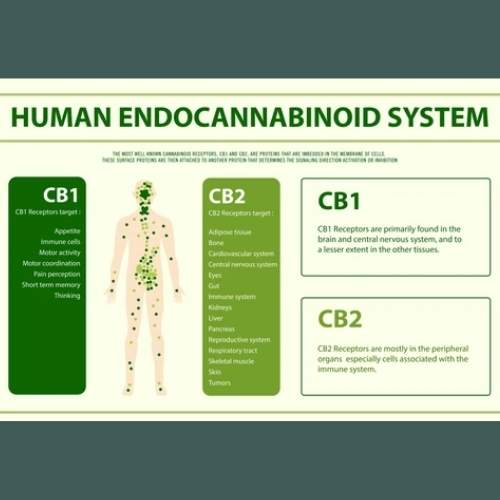The Endocannabinoid System

AUTHORED BY: GENESTER WILSON-KING, MD FACOG & SARAH RUSSO
The Endocannabinoid System
The discovery of the endocannabinoid system (ECS) has revolutionized our concept of science and health. This system is pervasive throughout the body and regulates many important physiologic pathways. It isn’t just humans that have it. All animals, even worms have one as well. [1] Investigation of the ECS catalyzed a deeper understanding of our bodies and many conditions affecting them.
The ECS was discovered in 1992 when researchers injected THC (tetrahydrocannabinol- a compound from cannabis) into human subjects and tracked its influence across the body. [2] Endocannabinoids and their receptors are found in the brain, organs, glands, connective tissues, and immune cells. Even the mitochondria, the powerhouses of our very cells, are influenced by the endocannabinoid system. [3] In each part of our bodies, the ECS has different roles. But the end target is always to bring us back into balance. The ECS serves these primary functions:
- Sleep
- Eat
- Relax
- Protect
- Forget
- Homeostasis (the maintenance of balance).
When we break it down like that, the ECS influences almost everything.
How the ECS Functions
How does the endocannabinoid system affect so many aspects of our experience? It does so by weaving various processes within our body together. The ECS is a complex network of endocannabinoids, enzymes that synthesize or break them down, and receptor sites. The three basic components of the ECS are:
Cannabinoid receptors- There are two main kinds of receptors. Cannabinoid Type 1 (CB1) is found in the brain and spinal cord and other major organs (the heart, liver, uterus, testis, and gastrointestinal tract). CB1 is responsible for mediating pain response, mood, memory, and motor function depending on where they are located. THC docks to these receptor sites, which is the reason it has a psychoactive effect. [4] Cannabinoid Type 2 receptors (CB2) are mostly found in cells of the immune system. These receptors are also responsible for the inflammatory response throughout the body. CBD does not directly bind to endocannabinoid receptors but impacts the ECS in other ways (Visit “What is CBD?” on Treadwell site). These receptors can be influenced by the different types of cannabinoids (more below).
Endocannabinoids- We all naturally produce our body’s own cannabinoids (endo- means “within the body”). Two key endocannabinoids have been identified so far: anandamide (AEA) and 2-arachidonoylglyerol (2-AG). Endocannabinoids can bind to either CB1 or CB2 receptors. The end result depends on which endocannabinoid is at play and wherein the body the receptor it influences is located. [5]
Enzymes produce and break down endocannabinoids. Endocannabinoids are made on-demand in response to illness or injury. The enzyme that synthesizes anandamide (AEA) is N-acyl-phosphatidylethanolamine phospholipase D (NAPE-PLD). The other endocannabinoid, 2-AG, is synthesized by diacylglycerol lipase. The main enzymes that breakdown the endocannabinoids are fatty acid amide hydrolase (FAAH), which works on anandamide. The other, monoacylglycerol acid lipase, generally degrades 2-AG. [6]
Different types of cannabinoids
There are three sources of cannabinoids. Some are made by our own bodies, others come from plant sources (mainly cannabis), and the rest are artificially made.
- Endocannabinoids are produced in the human body in response to injury or exercise or to regulate various functions.
- Phytocannabinoids are those found in the cannabis plant. There are over 200 cannabinoids in cannabis, many of which have yet to be identified. Tetrahydrocannabinol (THC), cannabidiol (CBD), and cannabinol (CBN) are the most common. [7]
- Synthetic cannabinoids are those produced by research laboratories or pharmaceutical companies (Marinol, Cesamet)
Why is the ECS helpful for so many conditions?
The endocannabinoid system is a crucial component that influences almost every aspect of how our body works. It is the widest spread receptor system we have that plays a vital role in alleviating misalignment and treating chronic conditions. The reason many people may haven’t heard about the endocannabinoid system before is because of its relation to cannabis. While components in cannabis directly influence the endocannabinoid system, there are many other ways to ensure it can function optimally.
Do you want to know what food and activities can enhance your own endocannabinoid function? See our next article, Endocannabinoid-Enhancing Foods and Activities.
 Genester Wilson-King, MD FACOG is a Board-Certified Obstetrician and gynecologist with over 25 years of clinical experience providing compassionate and research-driven care to patients. After years of working as a full-service OB/GYN, she founded Victory Rejuvenation Center (VRC), a private holistic and preventive medicine practice that provides life-transforming management modalities and customized medicines to patients. She is the Medical Advisor to Treadwell Farms.
Genester Wilson-King, MD FACOG is a Board-Certified Obstetrician and gynecologist with over 25 years of clinical experience providing compassionate and research-driven care to patients. After years of working as a full-service OB/GYN, she founded Victory Rejuvenation Center (VRC), a private holistic and preventive medicine practice that provides life-transforming management modalities and customized medicines to patients. She is the Medical Advisor to Treadwell Farms.
As the Medical Director of VRC, Dr. Wilson-King provides services that help her patients age gracefully and achieve holistic well-being. She focuses on plant-based medicine, integrated health, nutrition, supplements, cannabis education, and hormone balance.
Dr. Wilson-King is Co-Vice President of the Society of Cannabis Clinicians (SCC). The SCC is an educational and scientific society of physicians and other professionals dedicated to the promotion, protection and support of cannabis for medical use. Dr. Wilson-King co-authored the Best Practices Guidelines for Cannabis Use in Pregnancy and Breastfeeding, and Cannabis Use in Women – Special Considerations (in progress). She is also on the Board of the Doctors For Cannabis Regulation (DFCR), the first and only national physicians’ association dedicated to the legalization and regulation of cannabis for adults. Advancing the DFCR’s commitment to addressing the disproportionate criminalization of cannabis use among communities of color and the nation’s poor, she regularly provides expert opinions for legal cases involving cannabis.
Dr. Wilson-King is a nationally recognized advocate, clinician, and educator for cannabis and hormone and wellness therapies. She presents on cannabis use in obstetrics and gynecology, hormone therapy for PMS, various stages of menopause, and for applications in nutrition.
 Sarah Russo is a longtime plant enthusiast and globetrotter. She got her degree in environmental studies and social justice, with a focus on plant medicine from the Evergreen State College. She is a freelance writer, consultant, and project manager with over 13 years of experience in the cannabis and herbal medicine space. Her main objectives are fighting for the right to use plants, implementing social justice approaches in the cannabis industry, as well as encouraging sustainable agricultural practices. She is currently based on an island in the Mediterranean. Sarah is a content creator for Treadwell Farms.
Sarah Russo is a longtime plant enthusiast and globetrotter. She got her degree in environmental studies and social justice, with a focus on plant medicine from the Evergreen State College. She is a freelance writer, consultant, and project manager with over 13 years of experience in the cannabis and herbal medicine space. Her main objectives are fighting for the right to use plants, implementing social justice approaches in the cannabis industry, as well as encouraging sustainable agricultural practices. She is currently based on an island in the Mediterranean. Sarah is a content creator for Treadwell Farms.
Sources:
- Batugedara HM, et al. Host- and Helminth-Derived Endocannabinoids That Have Effects on Host Immunity Are Generated during Infection. Infect Immun., 2018.
- Pertwee, Roger. Cannabinoid pharmacology: the first 66 years. Br J Pharmacol., 2006.
- Devitt-Lee, Adrian. (2016). Mitochondria Mysteries: Homeostasis, renewal and the endocannabinoid system. Project CBD.
- Zou & Kumar. Cannabinoid Receptors and the Endocannabinoid System: Signaling and Function in the Central Nervous System. Int J Mol Sci., 2018
- Raypole, Crystal. (2019). A Simple Guide to the Endocannabinoid System. Healthline.
- McPartland et al. Care and Feeding of the Endocannabinoid System: A Systematic Review of Potential Clinical Interventions that Upregulate the Endocannabinoid System. PLoS One., 2014.
- Russo, Ethan. Taming THC: potential cannabis synergy and phytocannabinoid-terpenoid entourage effects. Br J Pharmacol., 2011.






